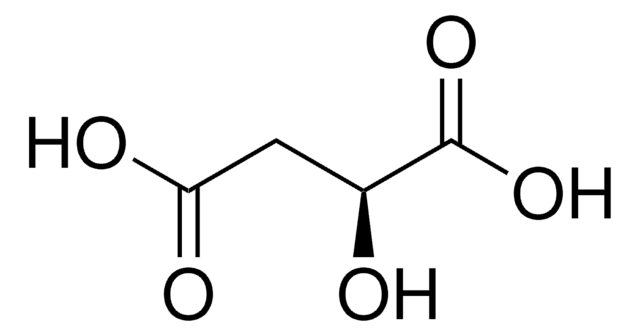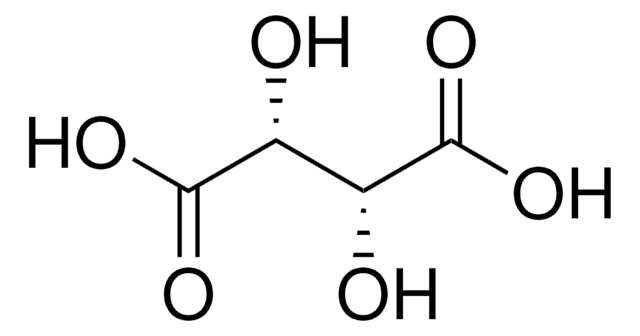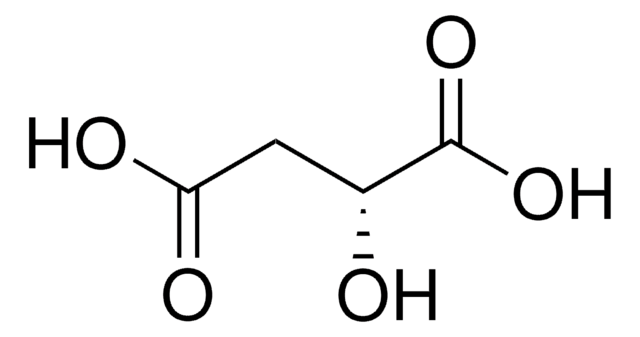27606
DL-Malic acid
meets analytical specification of FCC, E296, 99-100.5% (alkalimetric)
Synonyme(s) :
(±)-2-Hydroxysuccinic acid, DL-Hydroxybutanedioic acid
About This Item
Produits recommandés
Densité de vapeur
4.6 (vs air)
Niveau de qualité
Pression de vapeur
<0.1 mmHg ( 20 °C)
Essai
99-100.5% (alkalimetric)
Forme
solid
Activité optique
[α]/D −0.10 to +0.10°
Température d'inflammation spontanée
644 °F
Qualité
meets analytical specification of FCC, E296
Technique(s)
IR spectroscopy: suitable
Impuretés
≤0.05% maleic acid
≤0.1% water insoluble matter
≤1% fumaric acid
Résidus de calcination
≤0.1% (as SO4)
Pf
129-133 °C
131-133 °C (lit.)
Solubilité
acetone: soluble 17.75 g/ 100 gm at 20 °C
diethyl ether: soluble 0.84 g/100 gm at 20 °C
dioxane: soluble 22.70 g/100 gm at 20 °C
ethanol: soluble 45.53 g/100 gm at 20 °C
methanol: soluble 82.70 g/100 g at 20 °C
water: soluble 55.8 g/100 gm at 20 °C
benzene: insoluble
Traces de cations
As: ≤3 mg/kg
Hg: ≤1 mg/kg
Pb: ≤2 mg/kg
Adéquation
complies for identity (IR)
Application(s)
pharmaceutical (small molecule)
Chaîne SMILES
OC(CC(O)=O)C(O)=O
InChI
1S/C4H6O5/c5-2(4(8)9)1-3(6)7/h2,5H,1H2,(H,6,7)(H,8,9)
Clé InChI
BJEPYKJPYRNKOW-UHFFFAOYSA-N
Vous recherchez des produits similaires ? Visite Guide de comparaison des produits
Application
Actions biochimiques/physiologiques
Mention d'avertissement
Warning
Mentions de danger
Conseils de prudence
Classification des risques
Eye Irrit. 2
Code de la classe de stockage
11 - Combustible Solids
Classe de danger pour l'eau (WGK)
WGK 1
Point d'éclair (°F)
397.4 °F
Point d'éclair (°C)
203 °C
Équipement de protection individuelle
dust mask type N95 (US), Eyeshields, Gloves
Faites votre choix parmi les versions les plus récentes :
Déjà en possession de ce produit ?
Retrouvez la documentation relative aux produits que vous avez récemment achetés dans la Bibliothèque de documents.
Les clients ont également consulté
Notre équipe de scientifiques dispose d'une expérience dans tous les secteurs de la recherche, notamment en sciences de la vie, science des matériaux, synthèse chimique, chromatographie, analyse et dans de nombreux autres domaines..
Contacter notre Service technique





